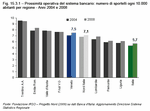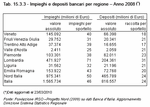(Note 1) In recent years, Italy's banking system has launched a process that has led to greater structuring within banks; this has meant on the one hand that large banking groups have been created and on the other that small and medium banks have set up federal networks. Although a market-led initiative, this transformation is the result of policies geared towards maintaining banking systems rooted in the country. There was, therefore, a dual, and at times conflicting, drive towards the evolution of the banking system; this drive was characterised by a market-led desire to rationalise bank structures, which however clashed with the need for a bank service that dealt with local development, both political and economic, a need that pushed for banks to limit their range of operation. All of this had repercussions on the productivity and geography of banking systems. Regarding productivity, the large banking groups that formed benefitted in terms of management efficiency, but they reduced their productivity at branch level, a move that helped out small and medium banking groups and, to some extent, foreign banks.
Although the banking system is still in the throes of major restructuring to recover the efficiency and effectiveness of local services, it is increasingly becoming a strategic infrastructure for regional and supra-regional development. As with all other infrastructures, attention to costs is not expected to penalise access because it is the services provided that foster the growth of links between banks and the local area. In other words, once the system has achieved a fair level of coverage, it is the quality of a bank's infrastructure that creates benefits, both big and small, for an area.
 The structure of the banking system The structure of the banking system
On 30 September 2009, there were about 20,000 branches in North Italy (Note 2), almost 58% of the branches in Italy, and they constituted a widespread network across the area.
A comparison of branch distribution in Italy reveals that Lombardia accounts for almost one-fifth, while the number in Veneto, Piemonte and Emilia Romagna ranges from 8% to 11% of the national total (Table 15.3.1).
Considering the resident population, we can build a bank proximity indicator (Note 3) that enables us to measure the extent of banking-system penetration within the area. This indicator places Veneto, with its 7.5 branches per 10,000 residents, well above the average for North Italy. Over the last five years, all regions, except for Valle d'Aosta and Trentino Alto Adige, experienced an increase in bank proximity. This means that the growth of branches was higher than population growth, a phenomenon that can be accounted for by a range of strategic factors. Some of these factors are down to attempts to offer more and better services to customers, with particular regard to local needs. The highest increases in bank proximity were in Lombardia, Veneto and Emilia Romagna (Figure 15.3.1).
A breakdown of figures by bank size (Note 4) reveals the structural dynamics of the region's credit system. This highlights on the one hand a reduction in the branches of large banks, a 4% drop in the North, while on the other a general growth in the local credit system. In September 2009, both minor and small banks had seen their branches grow by one-quarter on 2004. In Veneto, however, this trend translates into a slump in the number of branches of major banks and into an increase in banks of all other sizes, with particular growth being experienced by small banks (Table 15.3.2).
 Intermediation and regional strategies Intermediation and regional strategies
As we have spoken about the coverage of the credit system, we should now take a look at the entrenchment of the local system, which links in with the banking system's relationship with local agents, families, business and institutions. The level of entrenchment can be gauged by observing the bank intermediation process, as it is an indicator of a credit system's ability to gain and to fuel the confidence of savers and investors, i.e. the former being mainly families and the latter businesses. In 2008, Veneto's banks had high figures for loans, 40 million euro per branch, in third place behind Lombardia and Emilia Romagna; figures for deposits, however, were low. Veneto's 18-million-euro worth of deposits, alongside the 17 million euro of Trentino Alto Adige, is the lowest in North Italy, with a negative balance of about 20% on the average macroregional figure (Table 15.3.3).
If we observe the level of resources 'returned' to the area, which is calculated by the loans-deposit balance, in ratio to the resident population, in 2008, North Italy had a value of about 19 million euro per 10,000 residents, i.e. 1,900 euro per resident, 60% higher than the national average. The regions with the highest return are Lombardia, with 2,800 euro per resident, and Trentino Alto Adige, with 2,000 euro per resident. Then come Emilia Romagna, which is in line with the average for North Italy, and Veneto, which, with 1,600 euro per resident, is below the average for North Italy. However, in the other major northern regions, such as Piemonte and Friuli Venezia Giulia, the return is also rather low, being about half of the average for North Italy.
In recent years, the credit system has grown rather selectively within the area. On the one hand, although bank proximity has grown, on the other it has happened in different areas in accordance with the size of the bank group. With this in mind, from 2004 to September 2009, the credit system was found to be shifting the balance of development away from the North-West towards a new financial triangle between Milano, Venezia and Bologna. The most interesting aspect of this process, however, is the return and the promotion of the relationships with local customers. Indeed, figures reveal that the growth in branch numbers was generally due to the small and medium bank groups, yet until recently it was believed that only large bank groups would be able to fully satisfy the ever-changing needs of customers. Branch productivity, however, is unsatisfactory, both for the larger and the smaller groups, each for different reasons, although both have been affected by the economic and financial crisis. The smaller groups have been penalised by the difficulty of branching into intermediation, which requires a more complex and diversified bank framework. The smaller banks are therefore merging and integrating, taking advantage of network economies, in order to make up for a deficit in the structure, variety and quality of their services.
The bank system in Veneto is more balanced than in other regions as it has smaller groups that have grown stronger over the years, to the extent that its network of small and medium banks, such as its credit cooperative banks, credit societies and savings banks, make up the biggest 'bank' in Veneto in terms of number of branches. The large and major banks hold less than 40% of the branches and about one-third of the loans and deposits. This means that the minor, small and medium banks in the credit system manage about two-thirds of the region's credit intermediation. The strategy of the major banks is mainly to recoup intermediation productivity, which basically means putting the local area and the client at the centre of the system. For the small and medium banks, however, the strategy is to continue the trend of growth of recent years by focusing more sharply on a portfolio of strategic in house services and by relying on an external network to supply specific services with high added value. Thus, small banks focus on bridging their structural weaknesses and can compete with large groups via network economies.
Though their two models are different, their two infrastructures complement one another and both of them can promote development within the economies of North Italy. Observing the credit system from above reveals that it is a thick network of local relations where each bank represents a node in the network, the size of which is governed by how central it is to the system, which in turn reflects a bank's ability to intermediate its resources. The structure of the network mirrors the market hierarchies within the system. What emerges is how the entire system is held together by the complementary nature of the different bank groups; the smaller groups need to cooperate within a network and then compete with bigger groups via this network in order to create an integrated system of financial services for the economic system.
|
| Table 15.3.1 |
 |
| Figure 15.3.1 |
 |
| Table 15.3.2 |
 |
| Table 15.3.3 |
 |
|









